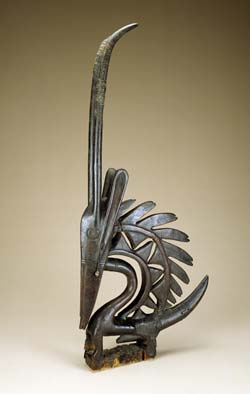
Few objects are so generally identified with African art as the Bamana chi wara crest mask. Often described as an antelope, it is actually a composite animal made up of the antelope, aardvark and pangolin. Some masks emphasize the broad neck and mane of the roan antelope. The vertical horns are similar to those of both the roan and oryx antelopes. The recessed panels around the eyes recall the facial markings of these antelopes also. The bodies of the chi wara suggest an aardvark with its big ears, short legs and thick tail, while a closer look at the incised surfaces suggest the scales of the pangolin.
 Antelope, aardvark and pangolin are all animals that dig up the earth: antelopes cut the ground with their hooves, while both the aardvark and pangolin use their claws to open termite mounds. This makes them fitting parts of Chi Wara, the supernatural being believed to have taught the Bamana peoples to farm. Young men once wore male and female pairs of masks in a dance performance that taught and praised good farmers. Today, the masquerade has become more entertainment. Antelope, aardvark and pangolin are all animals that dig up the earth: antelopes cut the ground with their hooves, while both the aardvark and pangolin use their claws to open termite mounds. This makes them fitting parts of Chi Wara, the supernatural being believed to have taught the Bamana peoples to farm. Young men once wore male and female pairs of masks in a dance performance that taught and praised good farmers. Today, the masquerade has become more entertainment.
Elsewhere in Africa, the pangolin is less associated with its digging claws and more with its sharp, scaled armor and tendency to roll up when threatened. Lacking teeth, it cannot really be considered aggressive but rather a master of transformation. This makes it appropriate as a symbol for the power and authority of chieftaincy as well as men's titled associations. Its skin is used in hats and costumes, and the animal is represented in a variety of forms including masks.

Male chi wara mask
Bamana peoples, Mali
Early to mid-20th century
Wood, metal, plant fiber, hide, cowrie shells
Bequest of Eliot Elisofon,
73-7-56
|

Hat
Ngombe peoples, Democratic Republic of the Congo
Early to mid-20th century
Pangolin skin, feathers, vegetable fibers
Purchased with funds provided by the Annie Laurie Aitken Endowment,
98-9-1
|
|
|
|